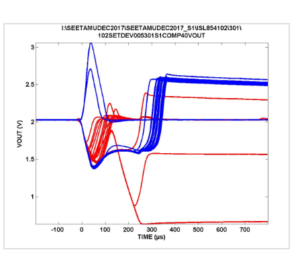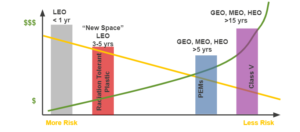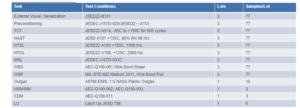Selection and Analysis of COTS power management devices under radiation
- Posted by Christophe Boucheron
- On December 3, 2019
- 0
COTS USE IN SMALL SATELLITE MISSIONS
- COTS components are being increasingly selected for small satellite missions
- Cost reductions are driving companies to make these selections
- In many cases, this can help reduce the cost of satellite production, while still maintaining high reliability
- Automotive COTS products seem to be a good option here
- COTS devices, even automotive have no radiation assurance
- Power management applications are especially sensitive to radiation effects, specifically SEE
- SEL/SEB can render a power management device un-usable and building in redundant power can be challenging
- SET can potentially damage downstream devices and mitigation techniques can be limited
- Radiation testing and selection can be expensive and take a significant amount of time…and in many cases, the COTS devices still do not perform
COTS COMPONENTS TESTED FOR RADIATION
- List of parts tested for radiation
- Total Dose testing and SEE testing (performed at Texas A&M University)
- These products were selected based on fab process or radiation performance of similar parts
- Even with Intersil’s background knowledge of the process and part design and experience with radiation effects , it can still be challenging to find COTS parts that have good radiation performance


ISL85410
- Serves as a cautionary tale for cots devices in space for power management
- Initial radiation testing showed that the part could withstand up to 43MeV without SEL/SEB
- Vin had to be de-rated from 40V (ISL85410) to 7V abs max, with an operating max of 5.5V
- Further SET testing showed significant transients at LET as low as 2.7MeV
- In light of this, we had no choice but to cancel the project
- In some cases, VOUT was supposed to be 2V but recovered after an ion strike where VOUT = 2.5V
- This is destructive to downstream devices
RENESAS SPACE PLASTIC PRODUCTS
SUPPORTING THE BROAD SPECTRUM OF SPACE

MISSION PROFILES
Rad Tolerant Plastic
- Expected Life Cycle ≤ 5 years
-
- Satellites will be replaced with system upgrades
-
- Low Earth Orbit (LEO)
- Less Total Radiation exposure and less susceptible to heavy ion strikes
- TID Target = 30krad(Si)
- SEE Target = LET of 43MeV∙cm2/mg
- Less Total Radiation exposure and less susceptible to heavy ion strikes
- Cost Sensitive (Cost can be ~10%-20% of Class V in high volume)
- Cost reduction areas
- Plastic package vs. hermetic
- Radiation characterized one time up front
- No ongoing in-line quality monitors, i.e. burn in
- Single temperature production testing (25C)
- Cost reduction areas
PEMs Plastic
- Expected Life Cycle > 10 years
- Satellites will be more traditional, with new weight and size requirements
- Medium/Geosynchronous Earth Orbit (MEO/GEO)
- High total radiation exposure
- TID Target = 75-100krad(Si)
- SEE Target = LET of 86MeV∙cm2/mg
- High total radiation exposure
- Not as cost sensitive
- Cost reductions are nice, but not a primary driver
- Board area savings are the driving factor
- Ongoing RLAT, SEE up front characterization
- 100% Burn-In and Temperature Cycle Testing
- Lot level quality monitors
- Tri-temp testing
RADIATION AND ELECTRICAL CHARACTERIZATION
- TID testing done at low rate, <10mrad/sec at facility in Palm Bay, FL
- Single event testing done at Texas A&M University
- SEL/SEB up to 43MeV∙cm2/mg
- SEU/SET potentially at lower LET levels
- 2 wafer lots electrical characterization done to full military temp range (-55C to +125C) target
- Data analysis and statistics are used to set data sheet and final test limits, final test at 25C only
- For PEMs up-screened parts, the characterization process is the same as above
- Radiation performance for TID is up to 75krad
- SEL/SEB up to 86MeV cm2/mg
- Production tri-temp testing is included for higher reliability
- Production flow follows AS6294/1 standard for plastic parts in space
RT PLASTIC QUALIFICATION TESTS

RT PLASTIC PRODUCT MANUFACTURING FLOW
Manufacturing
- Electrical acceptance testing based on WAT data
- No radiation wafer assurance testing
- Offshore assembly & test (non-China)
- Plastic package and enhanced lead frame
- 25C electrical screening (w/ -55C to +125C guard banded limits)
Change control & single manufacturing site for both assembly & test
- Same as Enhanced Product (EP) flow in this regard
RENESAS SPACE PLASTIC ADVANTAGES
- High Reliability Materials
- Lead frame: NiPdAg or NiPdAg-Au plated lead frame to mitigate tin whiskers
- Bond wires: Gold only, not copper
- Mold compound: High glass transition temperature
- Assembly site: Automotive assembly lines in Southeast Asia
- Passes NASA outgas testing
- Full military temperature range, -55⁰C to +125⁰C
- Support
- Renesas has many years of supporting customers in space applications
- Can assist with electrical, quality, reliability and radiation related questions
- Support is obtained through Hi Rel channels such as direct supportor via rep firms
- MOQ is 25 pieces
- Radiation Performance
- Radiation testing done for SEB/SEL/SEU/SET and TID – leads to known rad tolerant devices
Latest posts by Christophe Boucheron (see all)
- Selection and Analysis of COTS power management devices under radiation - December 3, 2019



0 comments on Selection and Analysis of COTS power management devices under radiation